
Microchip Technology (MCHP)
We wouldn’t buy Microchip Technology. Its low returns on capital and plummeting sales suggest it struggles to generate demand and profits, a red flag.― StockStory Analyst Team
1. News
2. Summary
Why We Think Microchip Technology Will Underperform
Spun out from General Instrument in 1987, Microchip Technology (NASDAQ: MCHP) is a leading provider of microcontrollers and integrated circuits used mainly in the automotive world, especially in electric vehicles and their charging devices.
- Products and services are facing significant end-market challenges during this cycle as sales have declined by 4.2% annually over the last five years
- Sales were less profitable over the last five years as its earnings per share fell by 20.6% annually, worse than its revenue declines
- Below-average returns on capital indicate management struggled to find compelling investment opportunities, and its decreasing returns suggest its historical profit centers are aging


Microchip Technology’s quality isn’t great. Better businesses are for sale in the market.
Why There Are Better Opportunities Than Microchip Technology
High Quality
Investable
Underperform
Why There Are Better Opportunities Than Microchip Technology
Microchip Technology’s stock price of $63.50 implies a valuation ratio of 28.9x forward P/E. This multiple expensive for its subpar fundamentals.
We’d rather pay up for companies with elite fundamentals than get a decent price on a poor one. High-quality businesses often have more durable earnings power, helping us sleep well at night.
3. Microchip Technology (MCHP) Research Report: Q3 CY2025 Update
Analog chipmaker Microchip Technology (NASDAQ:MCHP) met Wall Streets revenue expectations in Q3 CY2025, but sales fell by 2% year on year to $1.14 billion. On the other hand, next quarter’s revenue guidance of $1.13 billion was less impressive, coming in 4.3% below analysts’ estimates. Its non-GAAP profit of $0.35 per share was 4.9% above analysts’ consensus estimates.
Microchip Technology (MCHP) Q3 CY2025 Highlights:
- Revenue: $1.14 billion vs analyst estimates of $1.14 billion (2% year-on-year decline, in line)
- Adjusted EPS: $0.35 vs analyst estimates of $0.33 (4.9% beat)
- Adjusted Operating Income: $277.2 million vs analyst estimates of $264.7 million (24.3% margin, 4.7% beat)
- Revenue Guidance for Q4 CY2025 is $1.13 billion at the midpoint, below analyst estimates of $1.18 billion
- Adjusted EPS guidance for Q4 CY2025 is $0.37 at the midpoint, below analyst estimates of $0.39
- Operating Margin: 7.8%, down from 12.6% in the same quarter last year
- Free Cash Flow Margin: 4.5%, up from 2% in the same quarter last year
- Inventory Days Outstanding: 198, down from 213 in the previous quarter
- Market Capitalization: $32.81 billion
Company Overview
Spun out from General Instrument in 1987, Microchip Technology (NASDAQ: MCHP) is a leading provider of microcontrollers and integrated circuits used mainly in the automotive world, especially in electric vehicles and their charging devices.
Microchip is a leading provider of microprocessors (MPUs) which are made up of microcontrollers (MCUs) and Digital Signal Controllers (DSCs). Microcontrollers are effectively mini computers on a chip, they consist of a CPU, some memory, an analog chip, and a simple, application specific software that tells the chip what to do.
Microchip’s microcontrollers are low cost customized chips that are in thousands of products. Examples would be automobile engine control systems, implantable medical devices, remote controls, office machines, appliances, power tools, or toys.
Digital Signal Controllers are a variation of microcontroller that measures, filters and/or compresses digital or analog signals. They are used in motor control, power conversion, and sensor processing applications, often in the same types of systems as a microcontroller.
Microchip has a design ecosystem and library of off-the-shelf components that allows its customers to design any kind of custom microprocessor they can think of.
Microchips’ peers and competitors include Texas Instruments (NASDAQ:TXN), Skyworks (NASDAQ:SWKS), and Infineon (XTRA:IFX), among others.
4. Analog Semiconductors
Longer manufacturing duration allows analog chip makers to generate greater efficiencies, leading to structurally higher gross margins than their fabless digital peers. The downside of vertical integration is that cyclicality can be more pronounced for analog chipmakers, as capacity utilization upsides work in reverse during down periods.
5. Revenue Growth
A company’s long-term performance is an indicator of its overall quality. Any business can experience short-term success, but top-performing ones enjoy sustained growth for years. Microchip Technology struggled to consistently generate demand over the last five years as its sales dropped at a 4.2% annual rate. This wasn’t a great result and is a sign of lacking business quality. Semiconductors are a cyclical industry, and long-term investors should be prepared for periods of high growth followed by periods of revenue contractions.
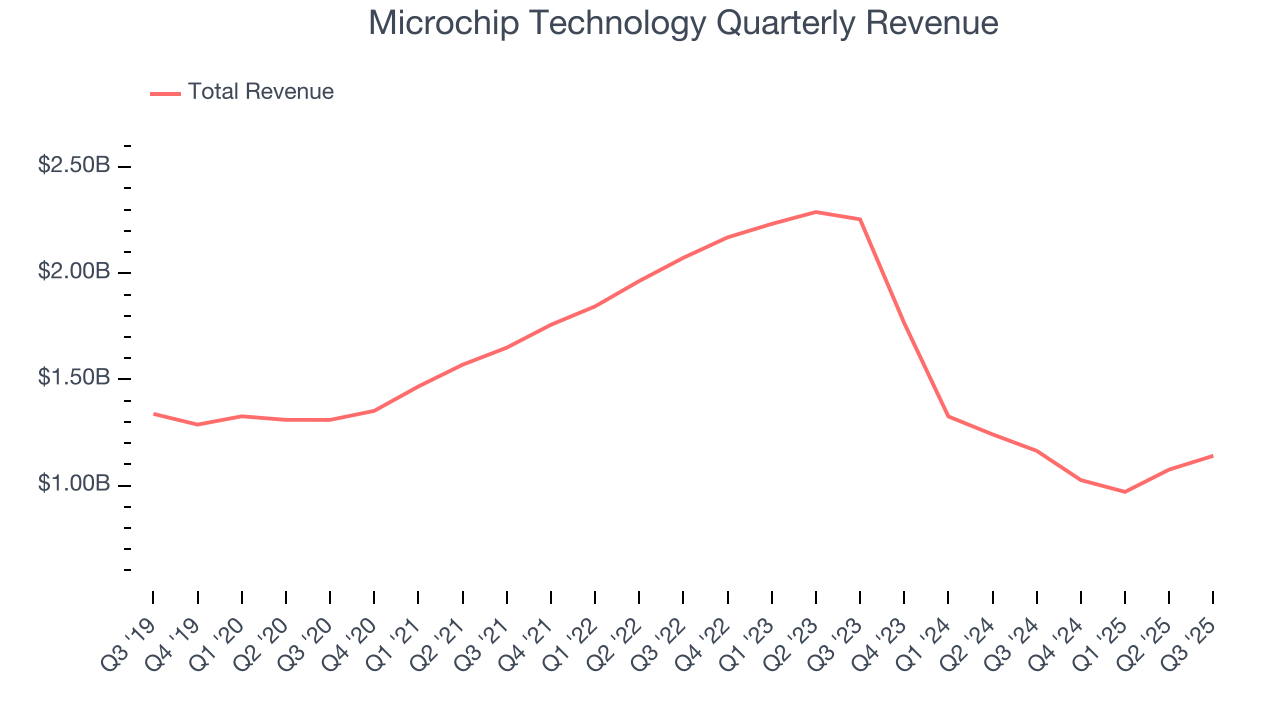
We at StockStory place the most emphasis on long-term growth, but within semiconductors, a half-decade historical view may miss new demand cycles or industry trends like AI. Microchip Technology’s recent performance shows its demand remained suppressed as its revenue has declined by 31.4% annually over the last two years. 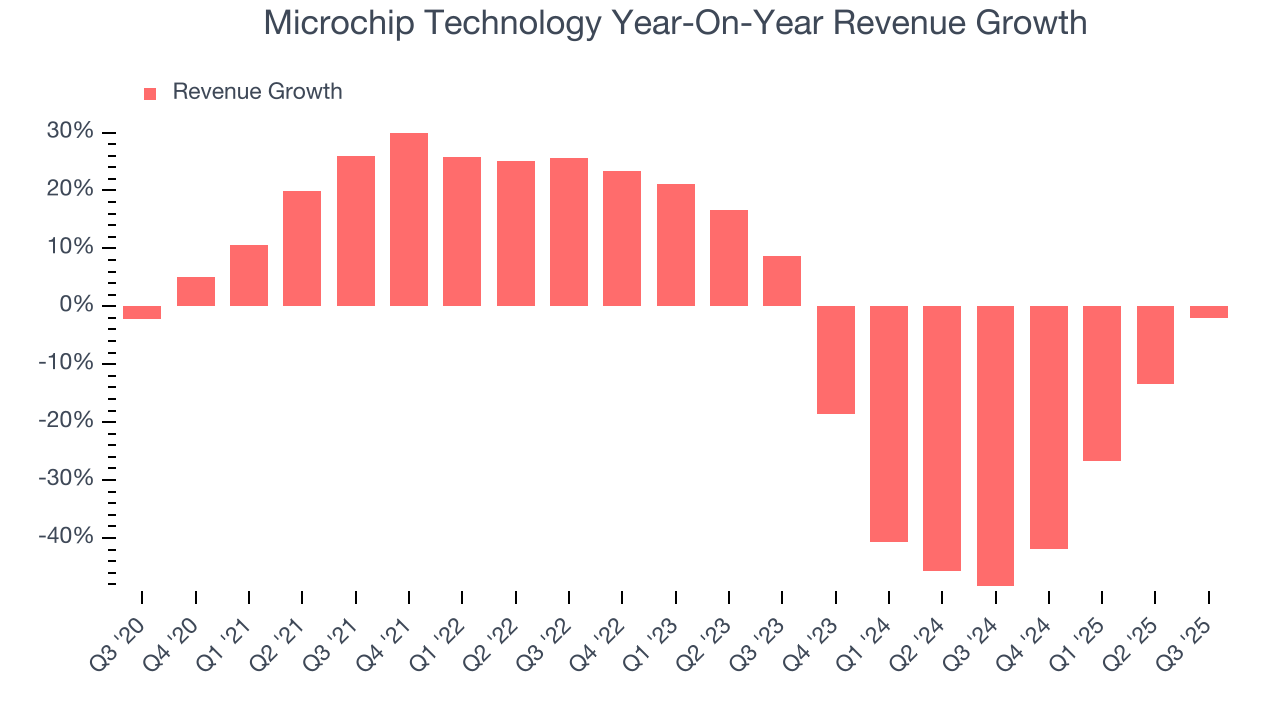
This quarter, Microchip Technology reported a rather uninspiring 2% year-on-year revenue decline to $1.14 billion of revenue, in line with Wall Street’s estimates. Despite meeting estimates, the drop in sales could mean that the current downcycle is deepening. Company management is currently guiding for a 10% year-on-year increase in sales next quarter.
Looking further ahead, sell-side analysts expect revenue to grow 23% over the next 12 months, an improvement versus the last two years. This projection is noteworthy and suggests its newer products and services will catalyze better top-line performance.
6. Product Demand & Outstanding Inventory
Days Inventory Outstanding (DIO) is an important metric for chipmakers, as it reflects a business’ capital intensity and the cyclical nature of semiconductor supply and demand. In a tight supply environment, inventories tend to be stable, allowing chipmakers to exert pricing power. Steadily increasing DIO can be a warning sign that demand is weak, and if inventories continue to rise, the company may have to downsize production.
This quarter, Microchip Technology’s DIO came in at 198, which is 27 days above its five-year average. These numbers suggest that despite the recent decrease, the company’s inventory levels are higher than what we’ve seen in the past.

7. Gross Margin & Pricing Power
Gross profit margin is a key metric to track because it shows how much money a semiconductor company gets to keep after paying for its raw materials, manufacturing, and other input costs.
Microchip Technology’s gross margin is well ahead of its semiconductor peers, and its strong pricing power is an output of its differentiated, value-add products. As you can see below, it averaged an excellent 57.6% gross margin over the last two years. Said differently, roughly $57.60 was left to spend on selling, marketing, R&D, and general administrative overhead for every $100 in revenue. 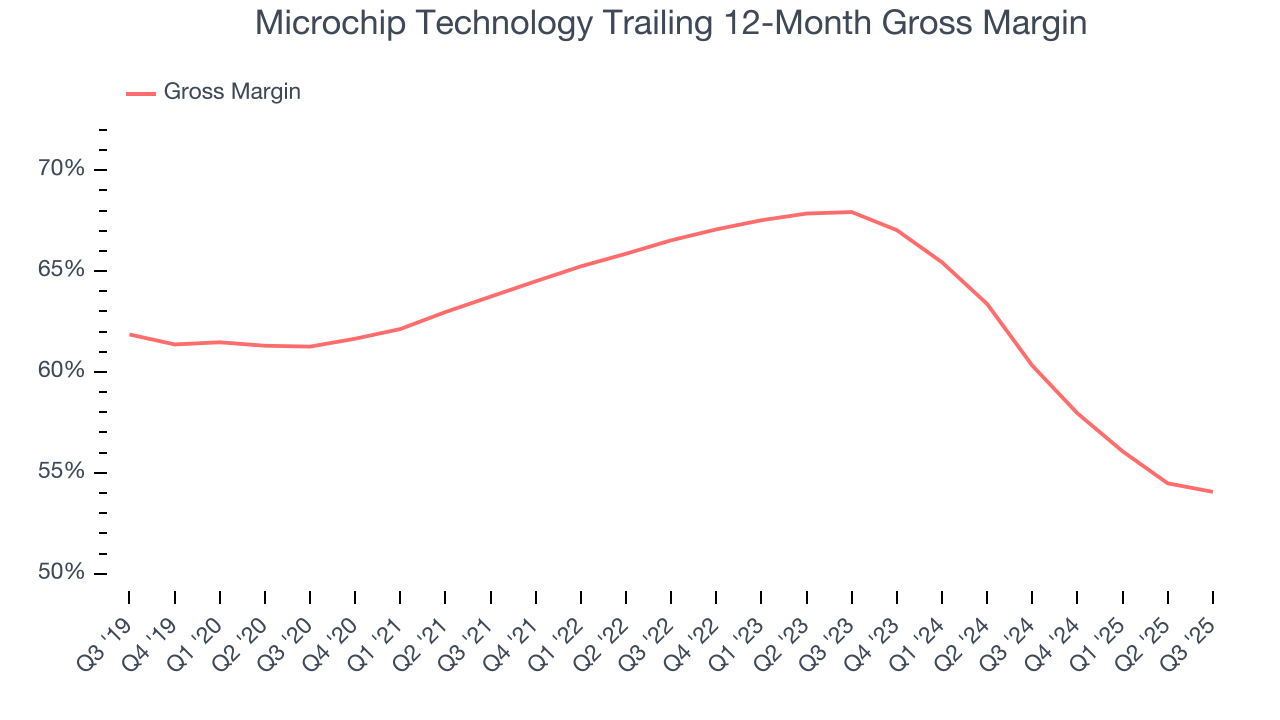
Microchip Technology produced a 55.9% gross profit margin in Q3, down 1.5 percentage points year on year. Microchip Technology’s full-year margin has also been trending down over the past 12 months, decreasing by 6.3 percentage points. If this move continues, it could suggest deteriorating pricing power and higher input costs (such as raw materials and manufacturing expenses).
8. Operating Margin
Microchip Technology was profitable over the last two years but held back by its large cost base. Its average operating margin of 12.4% was weak for a semiconductor business. This result is surprising given its high gross margin as a starting point.
Analyzing the trend in its profitability, Microchip Technology’s operating margin decreased by 20.9 percentage points over the last five years. Microchip Technology’s performance was poor no matter how you look at it - it shows that costs were rising and it couldn’t pass them onto its customers.
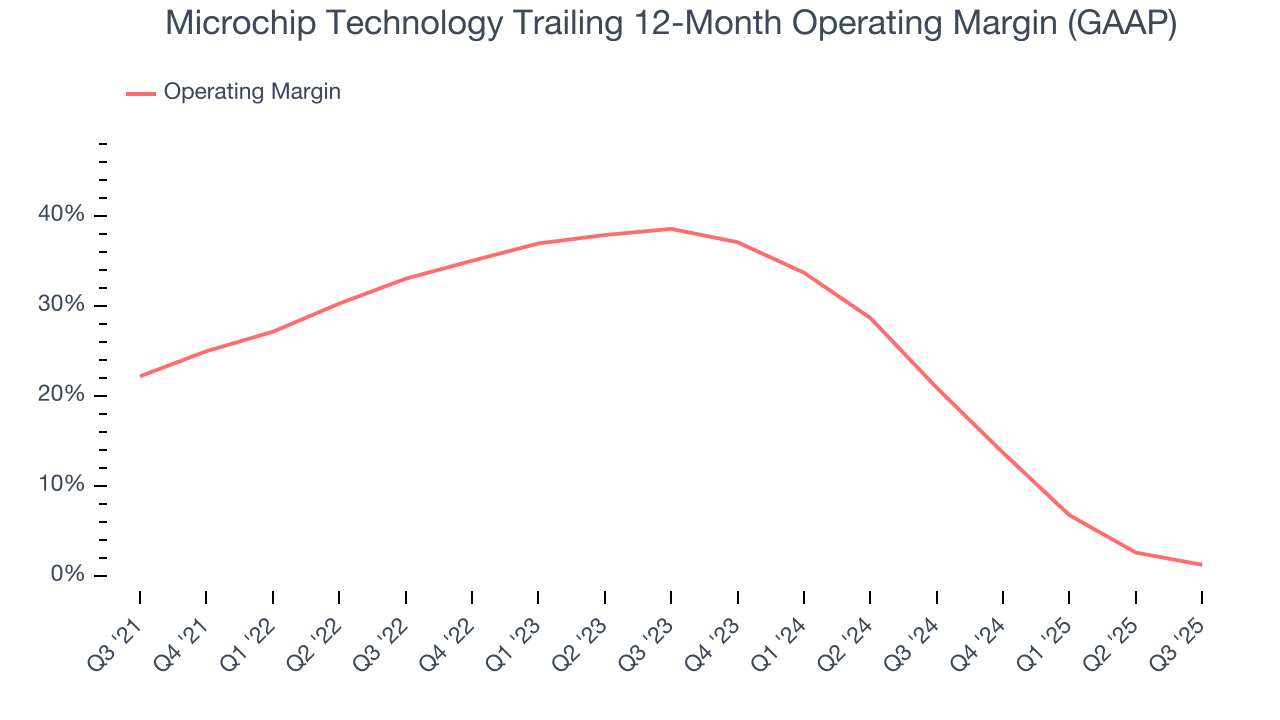
This quarter, Microchip Technology generated an operating margin profit margin of 7.8%, down 4.8 percentage points year on year. Since Microchip Technology’s operating margin decreased more than its gross margin, we can assume it was less efficient because expenses such as marketing, R&D, and administrative overhead increased.
9. Earnings Per Share
Revenue trends explain a company’s historical growth, but the long-term change in earnings per share (EPS) points to the profitability of that growth – for example, a company could inflate its sales through excessive spending on advertising and promotions.
Sadly for Microchip Technology, its EPS declined by 20.6% annually over the last five years, more than its revenue. This tells us the company struggled because its fixed cost base made it difficult to adjust to shrinking demand.

Diving into the nuances of Microchip Technology’s earnings can give us a better understanding of its performance. As we mentioned earlier, Microchip Technology’s operating margin declined by 20.9 percentage points over the last five years. Its share count also grew by 1.8%, meaning the company not only became less efficient with its operating expenses but also diluted its shareholders. 
In Q3, Microchip Technology reported adjusted EPS of $0.35, down from $0.46 in the same quarter last year. Despite falling year on year, this print beat analysts’ estimates by 4.9%. Over the next 12 months, Wall Street expects Microchip Technology’s full-year EPS of $0.93 to grow 118%.
10. Cash Is King
Free cash flow isn't a prominently featured metric in company financials and earnings releases, but we think it's telling because it accounts for all operating and capital expenses, making it tough to manipulate. Cash is king.
Microchip Technology has shown robust cash profitability, and if it can maintain this level of cash generation, will be in a fine position to ride out cyclical downturns while investing in plenty of new products and returning capital to investors. The company’s free cash flow margin averaged 23.3% over the last two years, quite impressive for a semiconductor business.
Taking a step back, we can see that Microchip Technology’s margin dropped by 14.5 percentage points over the last five years. Continued declines could signal it is in the middle of an investment cycle.
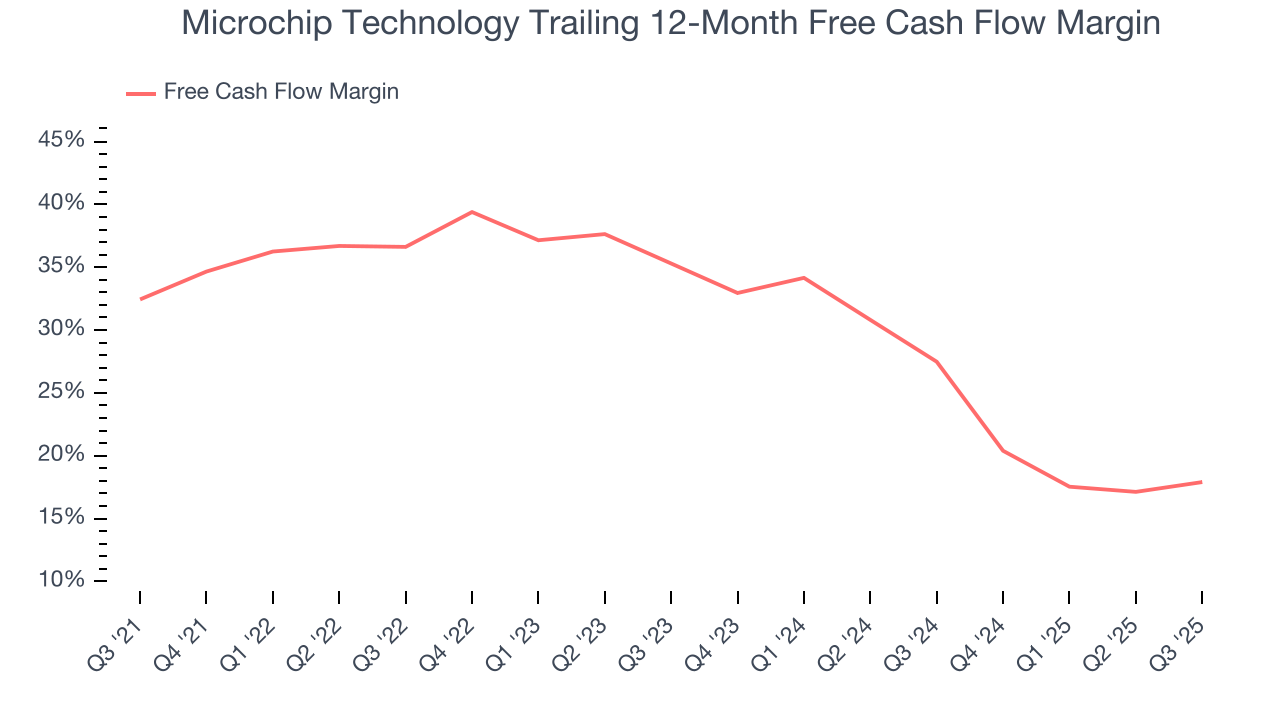
Microchip Technology’s free cash flow clocked in at $51.6 million in Q3, equivalent to a 4.5% margin. This result was good as its margin was 2.6 percentage points higher than in the same quarter last year, but we wouldn’t read too much into the short term because investment needs can be seasonal, leading to temporary swings. Long-term trends carry greater meaning.
11. Return on Invested Capital (ROIC)
EPS and free cash flow tell us whether a company was profitable while growing its revenue. But was it capital-efficient? Enter ROIC, a metric showing how much operating profit a company generates relative to the money it has raised (debt and equity).
Microchip Technology historically did a mediocre job investing in profitable growth initiatives. Its five-year average ROIC was 11.3%, somewhat low compared to the best semiconductor companies that consistently pump out 35%+.
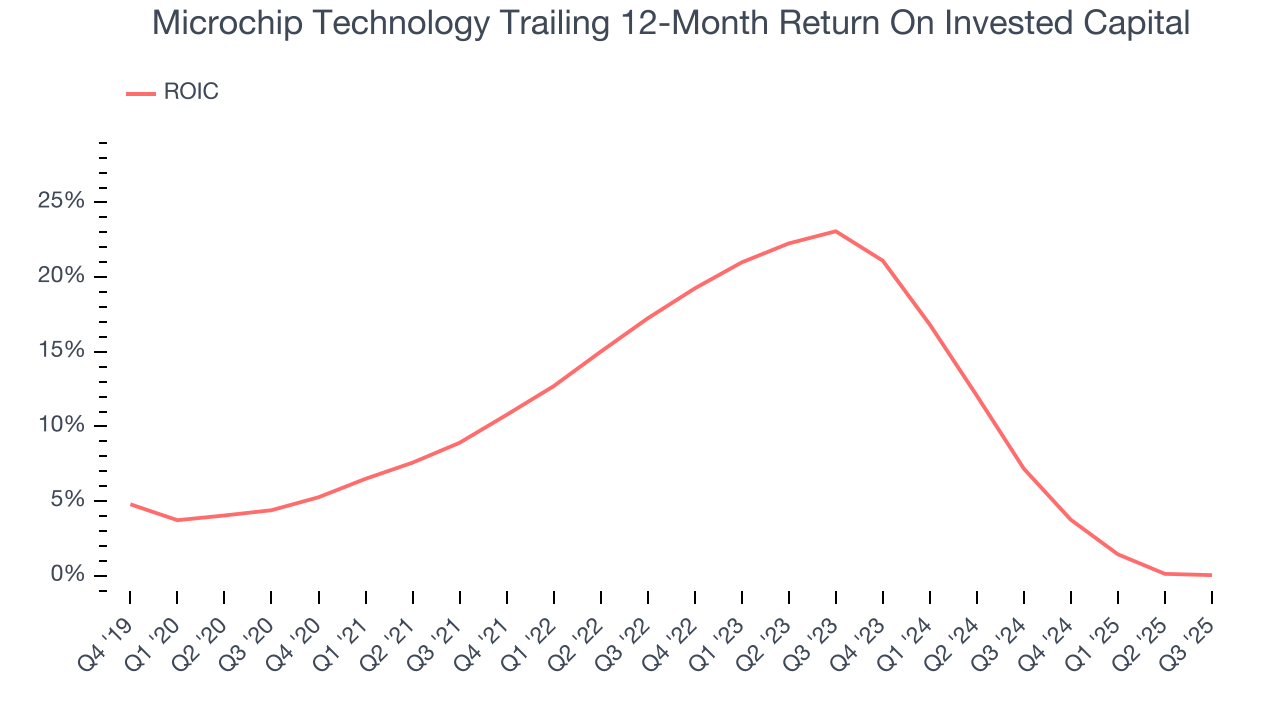
12. Balance Sheet Assessment
Microchip Technology reported $236.8 million of cash and $5.38 billion of debt on its balance sheet in the most recent quarter. As investors in high-quality companies, we primarily focus on two things: 1) that a company’s debt level isn’t too high and 2) that its interest payments are not excessively burdening the business.
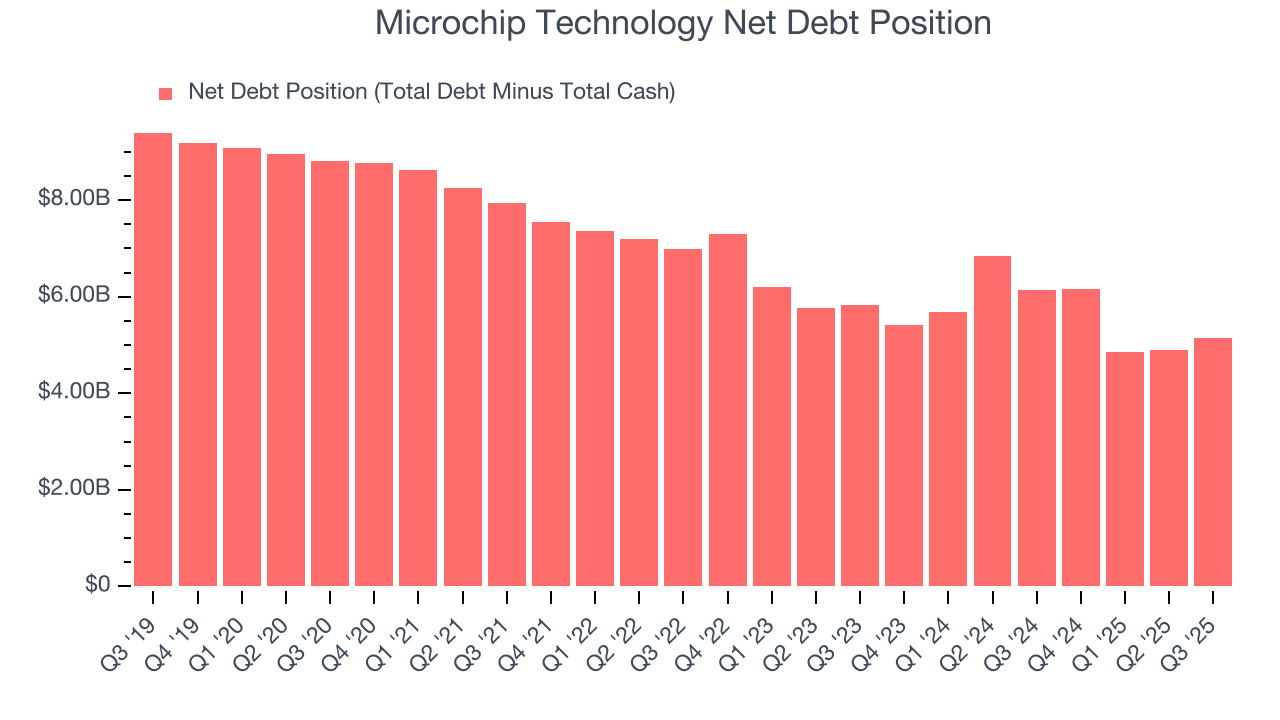
With $1.10 billion of EBITDA over the last 12 months, we view Microchip Technology’s 4.7× net-debt-to-EBITDA ratio as safe. We also see its $186.4 million of annual interest expenses as appropriate. The company’s profits give it plenty of breathing room, allowing it to continue investing in growth initiatives.
13. Key Takeaways from Microchip Technology’s Q3 Results
It was good to see a material improvement in Microchip Technology’s inventory levels. We were also glad its adjusted operating income outperformed Wall Street’s estimates. On the other hand, its revenue and EPS guidance for next quarter both missed, and this is weighing on shares. The stock traded down 6.1% to $55.74 immediately following the results.
14. Is Now The Time To Buy Microchip Technology?
Updated: December 4, 2025 at 9:27 PM EST
The latest quarterly earnings matters, sure, but we actually think longer-term fundamentals and valuation matter more. Investors should consider all these pieces before deciding whether or not to invest in Microchip Technology.
Microchip Technology doesn’t pass our quality test. To kick things off, its revenue has declined over the last five years. And while its projected EPS for the next year implies the company’s fundamentals will improve, the downside is its declining EPS over the last five years makes it a less attractive asset to the public markets. On top of that, its cash profitability fell over the last five years.
Microchip Technology’s P/E ratio based on the next 12 months is 32x. At this valuation, there’s a lot of good news priced in - we think other companies feature superior fundamentals at the moment.
Wall Street analysts have a consensus one-year price target of $73.72 on the company (compared to the current share price of $64.55).










